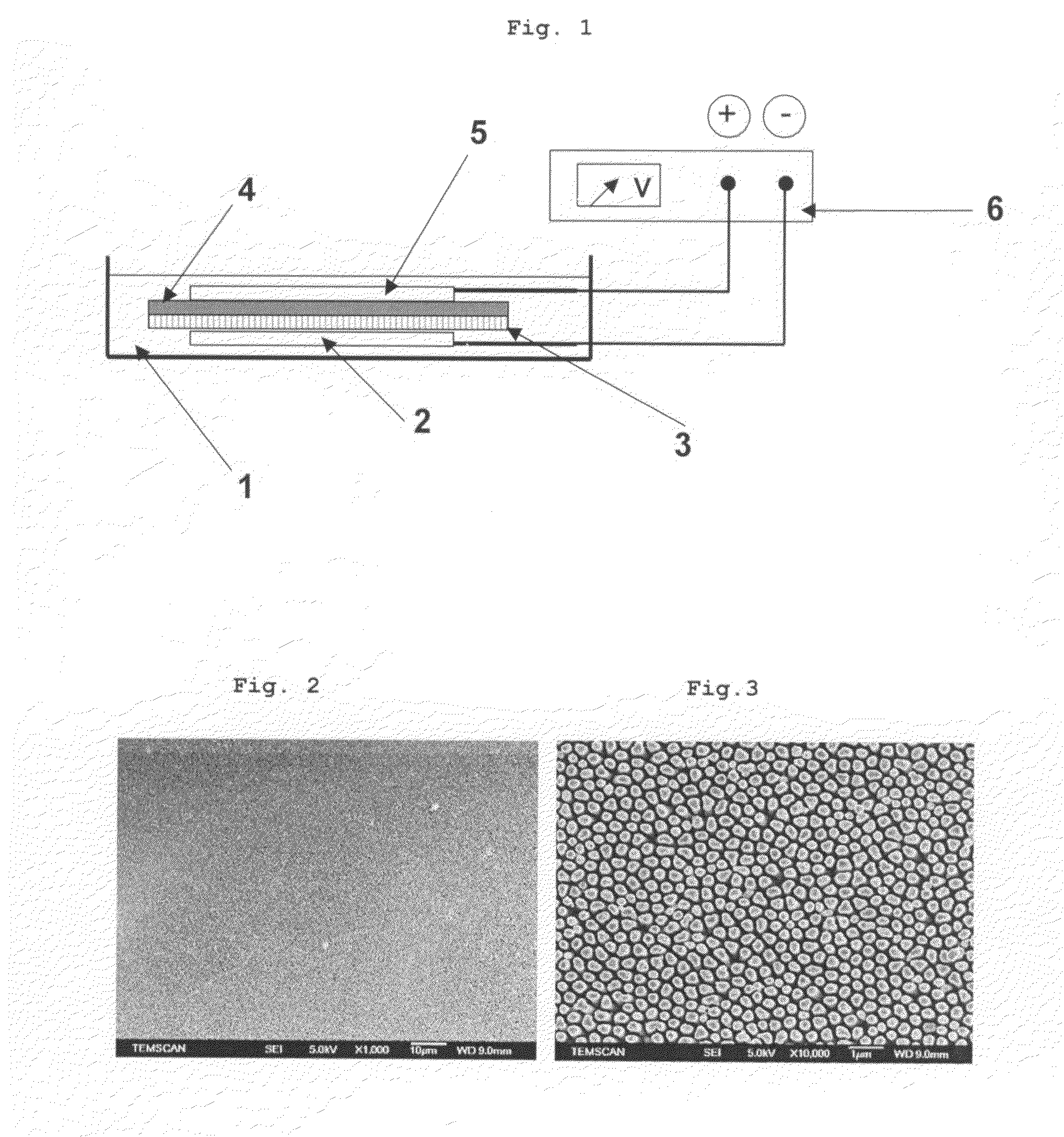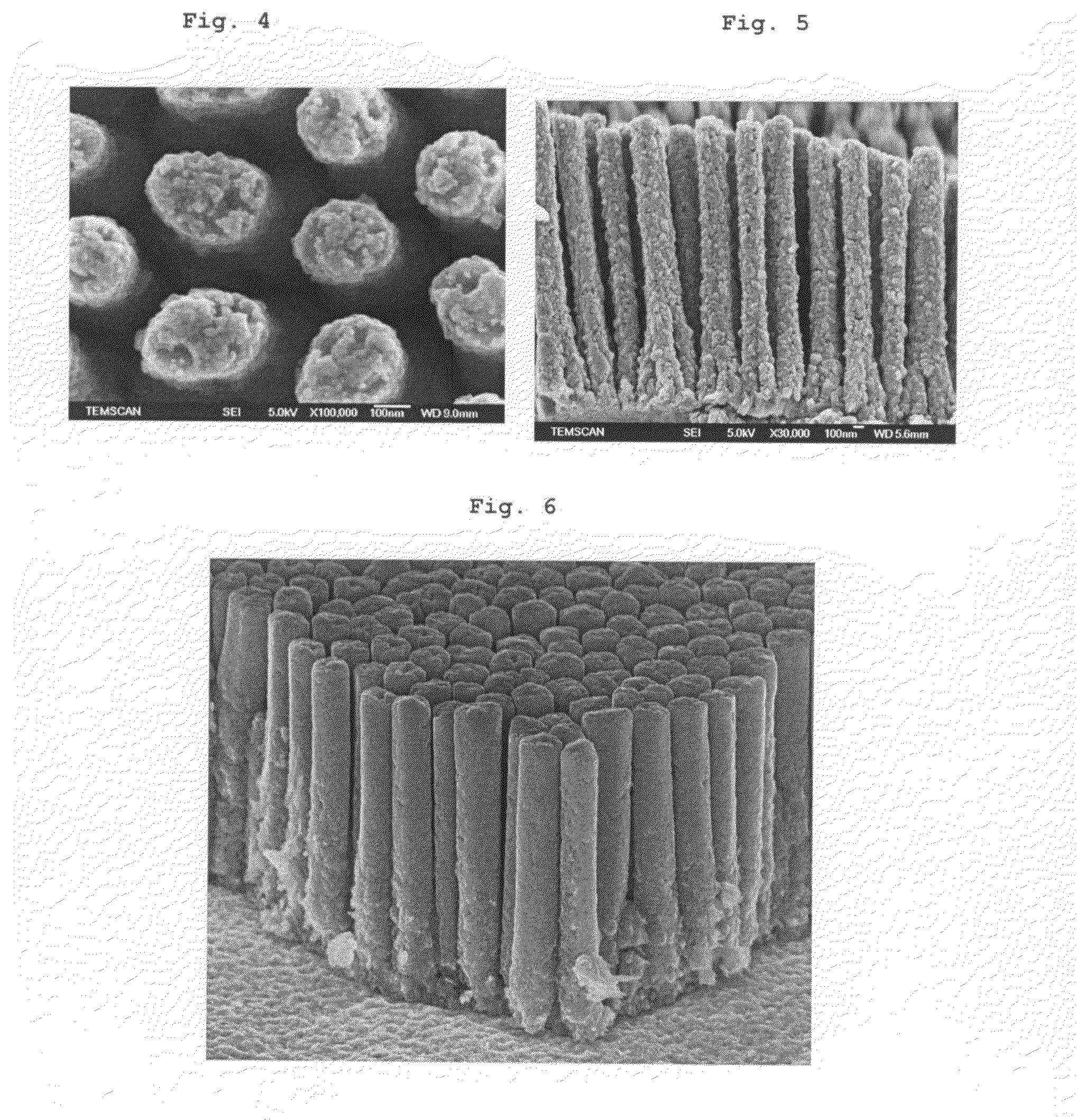Method for the Electrolytic Production of Self-Supporting Conductive Nanocomposite Elements
a technology of conductive nanocomposite elements and electrolysis, which is applied in the field of energy storage using batteries, can solve the problems of high cost of entire process, unfavorable mechanical strength of copper nanoelements on copper substrates, and complicated industrial scale implementation
- Summary
- Abstract
- Description
- Claims
- Application Information
AI Technical Summary
Problems solved by technology
Method used
Image
Examples
example 1
Deposition of Cu Nanowires on a Cu Substrate
[0072]The method was employed in an electrochemical cell containing an electrolyte in which an assembly, consisting of the following elements kept in contact with one another by pressure and stacked in the order mentioned, was immersed:[0073]copper foil, forming the cathode;[0074]alumina membrane;[0075]cellulose foil, forming the separator;[0076]copper foil, forming the anode.
[0077]The cathode and the anode were connected to the negative terminal and to the positive terminal, respectively of a potentiostat.
[0078]The copper foils forming the cathode and the anode respectively had a thickness of 500 μm.
[0079]The alumina membrane was a membrane sold under the name Anodisc by Whatman. It had a thickness of 50 μm and the diameter of the substantially cylindrical pores was 200 nm.
[0080]The electrolyte was an aqueous solution of (100 g / l) CuSO4, 20 g / l (NH4)2SO4 and 80 g / l DETA (diethylenetetra-amine).
[0081]The electrolysis was carried out with c...
example 2
Deposition of Sn Nanowires on a Cu Substrate
[0086]The operating method of example 1 was repeated, using:[0087]a Cu foil having a thickness of 500 μm, forming the cathode;[0088]an Anodisc alumina membrane;[0089]an Sn foil having a thickness of 500 μm, forming the anode.
[0090]The electrolyte was an aqueous solution containing SnSO4 (97 g / l), HSO4 (30 g / L), tartaric acid (30 g / l), a PEG 3500 polyethylene glycol (0.35 g / l), gelatin (1 g / l) and Na2SO4 (30 g / l).
example 3
Deposition of Copper Nanowires on a 3300 V / 100 A IGBT Chip
[0091]The operating method of example 1 was repeated, using:[0092]a 3300 V / 100 A IGBT (insulated-gate bipolar transistor) chip, forming the cathode;[0093]an Anodisc alumina membrane; and[0094]a Cu foil having a thickness of 500 μm forming the anode.
[0095]The electrolyte was an aqueous solution containing SnSO4 (97 g / l), H2SO4 (30 g / l), tartaric acid (30 g / l), a PEG 3500 polyethylene glycol (0.35 g / l), gelatin (1 g / l) and Na2SO4 (30 g / l).
[0096]FIG. 6 shows an FEG-SEM micrograph of the product obtained.
PUM
| Property | Measurement | Unit |
|---|---|---|
| thickness | aaaaa | aaaaa |
| thickness | aaaaa | aaaaa |
| thickness | aaaaa | aaaaa |
Abstract
Description
Claims
Application Information
 Login to View More
Login to View More - R&D
- Intellectual Property
- Life Sciences
- Materials
- Tech Scout
- Unparalleled Data Quality
- Higher Quality Content
- 60% Fewer Hallucinations
Browse by: Latest US Patents, China's latest patents, Technical Efficacy Thesaurus, Application Domain, Technology Topic, Popular Technical Reports.
© 2025 PatSnap. All rights reserved.Legal|Privacy policy|Modern Slavery Act Transparency Statement|Sitemap|About US| Contact US: help@patsnap.com



